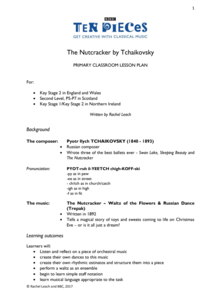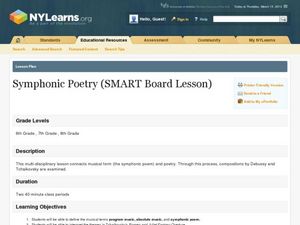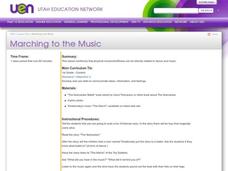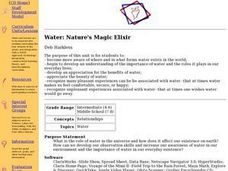BBC
The Nutcracker by Tchaikovsky
Over the course of six lessons, scholars try their hand at composing and dancing after a thorough examination of the famous ballet, The Nutcracker, by Tchaikovsky. Participants watch and discuss the performance of two dances, create and...
Pittsburgh Ballet Theatre
The Nutcracker Teacher Resource Guide
Clara becomes Marie, The Mouse King becomes a rat, and the Shadyside section of Pittsburgh becomes the setting for a modern interpretation of Tchaikovsky's famous ballet. Intended as a resource guide for a 2012 performance, the...
Curated OER
Tchaikovsky and the Nutcracker
Students study Peter Tchaikovsky, the author of the Nutcracker Suite. They listen to the associated music and view images of the author. They write a journal entry about their favorite part of the Nutcracker Suite.
Curated OER
The Nutcracker
First graders define a ballet as a story told through dance. They listen to melodies and demonstrate beat and accent through body movement. They watch the ballet.
San Francisco Symphony
Lesson Ideas for Any Music
Music is a wonderful tool you can add to enhance the learning process for every subject. Here is a list of music selections that are categorized by subject, along with some neat teaching suggestions. You'll find songs suited to...
Curated OER
Symphonic Poetry
Young scholars interpret the themes in Tchaikovsky's Romeo and Juliet Fantasy Overture, create a 6-line poem based on the themes in the Romeo and Juliet Fantasy Overture, and define musical terms related to the study of programmatic...
Curated OER
"Nutcracker"
Students recognize the timbre of a celesta by listening to music that contains the celesta. They listen to music from Tchaikovsky's "Danse de la Fee-Dragee" (Dance of the Sugar-Plum Fairies), track #14 and describe how the music...
Curated OER
Analyzing Two Dances and Making a Dance Map: The Nutcracker
Students discuss dance elements and create a dance map. They choose a dance theme and incorporate movement into their dance maps and choreography. They also experiment with different types of music.
Curated OER
Sharp and Smooth Movements: The Nutcracker
Students explore sharp and smooth movements. In two groups, students perform dances using sharp and smooth movements. They are asked to discuss the differences between the movements and how they felt when you watched or performed.
Curated OER
Sounds of the Season
During Christmas time, use common carols and Tchaikovsky's Nutcracker music as the basis for writing advertisements. Learners can work in teams or individually as they listen to songs via the links provided. A "Christmas Music Comparison...
Curated OER
Symphonic Poetry (SMART Board Lesson)
Let music and poetry collide in this well-orchestrated language arts lesson plan. After studying program music and C. Debussy's Prelude to an Afternoon Faun, view the attached SMART board lesson plan to read through "Fog" by Carl...
Curated OER
Marching to the Music
This lesson reinforces that physical movement/fitness can be directly related to dance and music. Tell the students that you are going to read a fun Christmas story. In the story there will be toys that magically come alive. Read the...
Curated OER
Hot, Hot, Hot, Cold
Learners dance the image of falling snow. They move, swing, fall, and rise to music working to depict snow falling, the sun, and high/low movements. This is a well-thought out lesson that aids them in seeing movement as a form of...
Hawaiʻi State Department of Education
Color Moods
Can art be a mode of communication? You bet it can! Learners explore how colors are used to convey mood in art. First, the class listens to three very unique musical selections that convey three different moods. Then, they compare and...
Curated OER
The Dancing Flute
Young scholars use a cardboard tubes as props as they create their own dance steps to express the emotions invoked in a portion of The Nutcracker by Tchaikovsky.
Smithsonian Institution
Our Story: Duke Ellington and Jazz
Get parents or guardians into the swing of things with a jazzy homework assignment. A detailed six-page guide provides before, during, and after reading suggestions for Duke Ellington: The Piano Prince and His Orchestra, Andrea Davis...
Curated OER
Duke Ellington and His Orchestra, Dance of the Floreadores, Waltz of the Flowers in the Meter of Duke
Students contrast the meter and style of two different versions of the musical piece, "Waltz of the Flowers." Duke Ellington's meter in the "Dance of the Floreadores" is compared to Tchaikovsky's version in the "Nutcracker."
Curated OER
Friendly Flowers
Students listen to music while creating flowers with a partner. They decide on a philanthropic act related to flowers. They recognize the difference between private property and common resources. They use a problem-solving model to...
Curated OER
Peter Ilyich Tchaikovsky
High schoolers identify what Tchaikovsky's personality was like and what kind of school he attended first. Then they identify and research what was happening in Russian politics during his lifetime. Students also identify who the...
Curated OER
Ballet and Dance Quiz
Ballet is the main focus of this short answer quiz, but a few questions cover dance in cinema and Scottish folk dance names. Trivia for dancers!
Curated OER
Emotions in Motion
Young scholars use dance as a form of communication. In this meanings of dance lesson, students create dances to communicate a variety of emotions.
Curated OER
Nature's Magic Elixir
Students do research to discover the importance of water in the world and its effect upon our daily lives. They will also appreciate the beauty of water and how it is so adaptable within nature.
Curated OER
Peter and the Wolf - Sequencing
Learners listen to the story of Peter and the Wolf and answer comprehension questions. They then will name the beginning, middle, and end of the story using a graphic organizer. Students then individually illustrate each part of the...
Curated OER
Flowering Philanthropy
Students plant flowers for others. They care for flowers. They summarize experiences through drawing, discussions and writing.

























